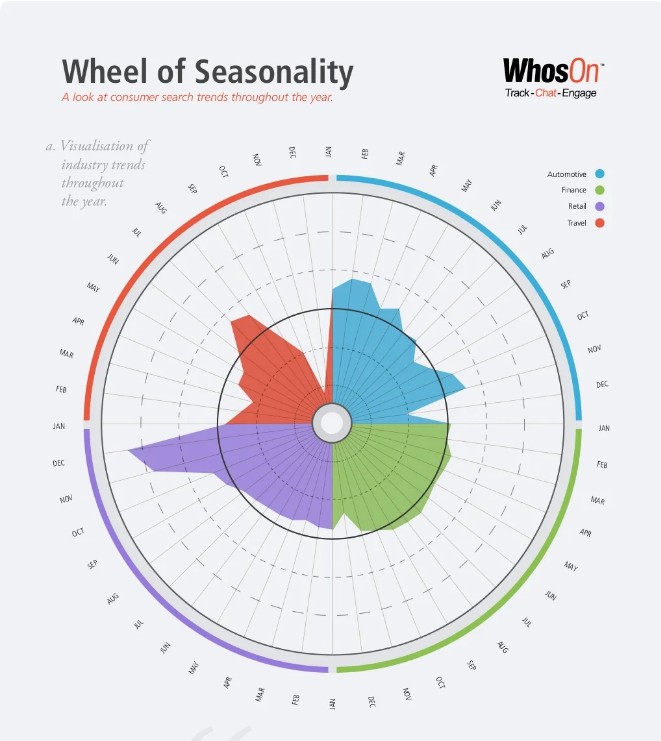
Most businesses experience seasonal peaks and dips in search demand throughout the year. Whether it’s a few weeks, or a few months – it’s important to plan for and optimise your website to maximise opportunities when demand is high and maintain organic search performance in the quieter periods.
Keep reading as we guide you through the best SEO strategies to manage seasonal demand before, during and after peak periods for year-round performance.
- Why seasonal SEO is important
- Seasonal demand looks different for every business
- How to determine when your seasonal demand is
- Is your peak really your peak?
- Tips for seasonal SEO – before peak seasons
- Tips for seasonal SEO – during peak seasons
- How to combat dips in traffic
- Next steps
Why seasonal SEO is important
While SEO is a long-term strategy which optimises your website all year round for sustained visibility, seasonal SEO can be thought of as an augmentation of your ongoing strategy. It helps your business to boost conversions during peak purchasing times.
Benefits of seasonal SEO include:
-
Maximises conversions during peak times
-
Helps your business to acquire new customers
-
Can return higher profit margins than PPC where Cost Per Click is high due to competition in peak periods
-
Informs reporting and removes ambiguity around fluctuations in performance
-
Prepares your website for sudden and unpredictable spikes in traffic
-
Enables you to plan business & marketing activities throughout the year
-
Helps your website appear for trending keywords
Seasonal demand looks different for every business
Seasonal demand varies from business to business.
A boiler company experiences peak demand during winter, with quieter periods in the warmer months.
A charity can expect peak donations around Christmas when customers feel the most charitable, whereas a tourism-based company will thrive in summer.
A B2B business may experience peak demand at the end of the fiscal year when budgets are agreed, but sales might taper off during the Christmas and summer holidays.
Common seasonal periods include:
-
Christmas, Halloween, Valentine’s Day etc
-
School/Summer holidays
-
Bank holidays
-
Summer, winter, autumn, spring
-
Black Friday / Cyber Monday
-
Budget cycles such as end of fiscal year
-
Back to school
-
New year
-
Big industry events – awards, conferences, product launches/announcements
The Wheel of Seasonality by Venn.com gives an indication of how seasonal demand varies for each industry.

How to determine when your seasonal demand is
Before considering your seasonal SEO strategy, it’s important to look at your data to really understand where the peaks are. Compare data to competitors, look at data from previous years, look at industry reports and predictions to get a comprehensive picture.
Some peaks will be more obvious than others – the Christmas period for ecommerce is usually a given. But for more nuanced peaks – such as the finance sector or other B2B businesses – this may take a little more digging.
Use tools to ascertain the peak times – Google Search Console and Google Trends are useful here.
Is your peak really your peak?
It’s important to determine whether your peak period really is seasonal demand or another factor such as a trending news item or a competitors’ website outage. The same goes for low periods – ensure your dips in conversions are not the result of underlying technical problems.
Seasonal demand looks different for every business and it’s important to know what’s specific to you.
Tips for seasonal SEO – before peak seasons
The most important stage to focus seasonal SEO efforts is the months before your peak.
1. Plan well in advance
Remember that SEO can take anywhere between 3-6 months to see results, so make sure to start well in advance.
Consider using sprints if you have multiple peaks throughout the year. This way you won’t spend all your time being reactive to peaks and can instead dedicate specific time to maximising seasonal opportunities.
2. Collaborate with other channels
If you’re approaching the peak period with a combined SEO/PPC strategy, make sure that you’re not cannibalising the same keywords – work together to establish a plan of action that helps each channel to inform the other.
3. Have seasonal content ready 2 months in advance
To ensure Google has time to crawl and index your seasonal content, make sure to prepare content around 2 months in advance to give it the best chance of ranking.
4. Refresh existing seasonal content
To maximise your existing content’s longevity and save time, try refreshing it with updates and additional information.
5. Create seasonal pages
Having dedicated page(s) for your peak season will help to build authority and is a great place to drive customers down the sales funnel.
Before the peak season add them to your menu and the footer to make them more visible to customers (and Google).
Remember to remove them when the period is over, but don’t delete the pages. Also avoid adding dates or the year in the URL/titles unless you plan to change them every year.
6. Plan backlink acquisition in advance
Ramp up your backlink acquisition activities in the months before your peak period so as to amplify your content as much as possible.
7. Check page loading speed and technical health/capacity
Shortly before the peak, use Core Web Vitals to check the loading speed of your website to ensure it is loading quickly. Ensure it is equipped to handle high volumes of traffic if you expect demand will be particularly high.
Tips for seasonal SEO – during peak seasons
This is the time to keep track of your SEO campaign to ensure any issues are identified early on and pages are as optimised as possible.
1. Ensure calls to action are clear
Strong calls to action are important to encourage conversions. Have key products or services promoted on the page with clear CTAs and keep an eye on daily search trends to identify where demand is and whether messaging needs to be adjusted.
2. Monitor website performance
Identify any problems as soon as possible – such as high bounce rate – to see what needs fixing.
Tips for seasonal SEO – during low seasons: how to combat dips in traffic
This is the time to not only lay the foundations for future peak periods, but also build your brand and visibility through traditional SEO techniques.
1. Produce stable content
Stable content is generally informative in nature, and which can help generate brand awareness throughout the year. Using tools such as SEMrush, research the popular, long-lasting topics for content in your sector and work on producing these to support organic visibility during the quieter months.
While visitors might not be customers straight away, they may come back to you when demand returns.
2. Create reactive content
Sometimes external factors such as industry news can be an excellent way to boost traffic during quieter months.
Use Google Trends and newsletters to keep a track of trending topics. Think creatively about how these topics can be linked back to your brand, but make sure it’s relevant and meaningful to your audience - irrelevant content won't perform as well thanks to Google's latest 'helpful content' update.
3. Schedule any large website projects during quieter months
Ensure infrastructure and technical updates are carried out during quieter months, so as not to interfere with performance during the peak season. Take the opportunity to audit content and see what can be improved upon to maintain visibility.
4. Review and update buyer personas
Customer needs are forever changing, and what worked last year might not work this year. Take the opportunity during the quieter periods to review your buyer personas and see what new challenges your customers are facing and create content to answer these.
Final word
TDMP creates high-performance, bespoke seasonal SEO strategies tailored to clients’ peak times to maximise their seasonal opportunity and ensure sustained performance all year round.
If you need help creating an effective seasonal SEO strategy – contact us today.

